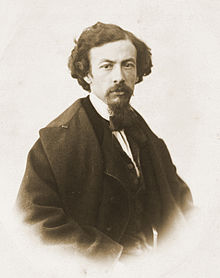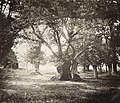Gustave Le Gray
Gustave Le Gray | |
|---|---|
 Gustave Le Gray, Self-portrait, late 1850s | |
| Born | 30 August 1820 Villiers-le-Bel, Val-d'Oise, France |
| Died | 30 July 1884 (aged 63) Cairo, Egypt |
| Known for | Painter, draughtsman, sculptor, print-maker, photographer |
| Notable work | Developed a number of photographic techniques |
| Spouse |
Palmira Maddalena Gertrude Leonardi
(m. 1844) |
| Children | 7 |
Jean-Baptiste Gustave Le Gray (French: [lə gʁɛ]; 30 August 1820 – 30 July 1884)[1] was a French painter, draughtsman, sculptor, print-maker, and photographer. He has been called "the most important French photographer of the nineteenth century" because of his technical innovations, his instruction of other noted photographers, and "the extraordinary imagination he brought to picture making."[2] He was an important contributor to the development of the wax paper negative.
Biography
Gustave Le Gray was born on 30 August 1820 in Villiers-le-Bel, Val-d'Oise.[1] He was an only child, and his parents encouraged him to become a solicitor's clerk, [citation needed] but from a young age, he aspired to be an artist. He was originally trained as a painter, studying under François-Édouard Picot and Paul Delaroche. His parents financed a trip to Switzerland and Italy so that he could study art abroad, and he lived in Italy between 1843-1846 and painted portraits and scenes of the countryside. In 1844, he met and married Palmira Maddalena Gertrude Leonardi (born 23 March 1823), a laundress who he had six children with, although only two survived into adulthood.[3]
Le Gray exhibited his paintings at the salon in 1848 and 1853.[1] He then crossed over to photography in the early years of its development.
He made his first daguerreotypes by 1847.[4] His early photographs included portraits; scenes of nature such as Fontainebleau Forest; and buildings such as châteaux of the Loire Valley.[4][5]

He taught photography to students such as
In 1855, Le Gray opened a "lavishly furnished" studio. At that time, becoming progressively the official photographer of Napoleon III, he became a successful portraitist. His most famous work dates from this period, 1856 to 1858, especially his seascapes. The studio was a fancy place, but in spite of his artistic success, his business was a financial failure: the business was poorly managed and ran into debts.[8] He therefore "closed his studio, abandoned his wife and children, and fled the country to escape his creditors."[4]
He began to tour the
He established himself in
In 1868, a collection of photographic seascapes by Gustave Le Gray was donated by millionaire art collector Chauncy Hare Townshend to the Victoria and Albert Museum. (He had kept them in portfolios along with his watercolors, etchings and engravings; they therefore remained in excellent condition, preserved to museum standards almost since they were made.)[10]
On 16 January 1883, he had a son with the nineteen-year-old Anaïs Candounia. Registration of their sons birth was voided due to lack of proof of Leonardi's death. Le Gray died on 30 July 1884, in Cairo.[1] His only surviving child from his marriage to Leonardi, Alfred, was designated as his heir.
Technical innovations

His technical innovations included:
- Improvements on paper negatives,[5] specifically waxing them before exposure "making the paper more receptive to fine detail".[11]
- A collodion process published in 1850 but which was "theoretical at best".[12] The invention of the wet collodion method to produce a negative on a glass plate is now credited to Frederick Scott Archer who published his process in 1851.[12]
- Combination printing, creating seascapes by using one negative for the water and one negative for the sky.[2][5][11]
Works
Le Gray documented French monuments on a mission for the French government with other French photographers.
He was a successful portrait photographer, capturing figures such as Napoleon III and Edward VII. He also became famous for his seascapes, or marine. He spent 20 years in Cairo, Egypt, but there are few works from this period.
World records for most expensive photograph sold at auction, 1999–2003

In October 1999, Sotheby's sold a Le Gray albumen print "Beech Tree, Fontainebleau" for £419,500, which was a world record for the most expensive single photograph ever sold at auction, to an anonymous buyer.[13] At the same auction, an albumen print of "The Great Wave, Sète" by Le Gray was sold for a new world record price of £507,500 or $840,370 to "the same anonymous buyer" who was later revealed to be Sheik Saud Al-Thani of Qatar.[13][14][15][16] The record stood until May 2003 when Al-Thani purchased a daguerreotype by Joseph-Philibert Girault de Prangey for £565,250 or $922,488.[17][18]
Books
- A practical treatise on photography, upon paper and glass by Gustave Le Gray, (translated by Thomas Cousins) London : T. & R. Willats, 1850.
- Photographic manipulation: the waxed paper process of Gustave Le Gray by Gustave Le Gray. Translated from the French. London: George Knight and Sons, 1853.
Gallery
- Architecture and landscapes
-
Central portal of theChurch of Saint-Jacques, Aubeterre, France (1851)
-
Train station with train and coal depot, digitally restored
-
Cloudy Sky - Mediterranean Sea
-
Seascape with Sailing Ship and Tugboat
-
Brig upon the Water
-
The Great Wave, Sète
-
Forest of Fontainebleau (1855)
-
Bateaux quittant le port du Havre (1855/1856)
-
Imperial yacht Reine Hortense (1856)
-
Forest of Fontainbleau (circa 1856)
-
Batterie Royale à Brest (1858)
-
Tour Saint-Jacques(1859)
-
Palermo (1860)
-
Waterfront village (Uzerche)
- Portraits
-
Henri Le Secq (1848)
-
Louis-Napoléon(1852)
-
Empress Eugenie(1856)
-
General István Türr (1860)
-
Alexandre Dumas (1860)
-
Camel transporting artillery, Egypt (1866)
-
Napoleon III, (1857)
- Paintings
-
Portrait of Mme G. L. (Palmira Leonardi, wife of the artist), 1853
-
Empress Eugénie, 1869, commissioned by Isma'il Pasha, given to the Empress on the occasion of the inauguration of the Suez Canal
-
Back from the Fountain, Cairo, 1873
Legacy
Caroline Shaw has a piano piece inspired by Le Gray (because of the "blurring of the edges" and "slowly coming into focus", according to Shaw[19]) and Chopin's Mazurka in A minor, Op. 17, No. 4.
See also
- Charles Nègre
- History of photography
- List of most expensive photographs
- Société française de photographie
References
- ^ a b c d Le Corre, Florence. Gustave Le Gray, a poet with a passion for excellence. Archived 2008-12-25 at the Wayback Machine "Translated from the catalogue Une visite au camp de Châlons sous le Second Empire: photographies de Messieurs Le Gray, Prévot..., Paris: musée de l'Armée, 1996, pp. 130-131." Retrieved September 15, 2008.
- ^ a b J. Paul Getty Museum. Gustave Le Gray, Photographer. July 9 - September 29, 2002. Retrieved September 14, 2008.
- ISBN 9780892366712.
- ^ a b c d Daniel, Malcolm (October 2004). "Gustave Le Gray (1820–1884) | The Metropolitan Museum of Art". Heilbrunn Timeline of Art History. Retrieved 2018-05-08.
- ^ a b c d Janis, Eugenia Parry. Gustave Le Gray. (French, 1820-1882). Museum of Modern Art, "from Grove Art Online." Oxford University Press, 2007. Retrieved September 15, 2008.
- ^ a b c d "Gustave Le Gray (French, 1820 - 1884) (Getty Museum)". The J. Paul Getty in Los Angeles. Retrieved 2018-05-08.
- ^ a b Metropolitan Museum of Art. Heilbrunn Timeline of Art History. Thematic Essays. Gustave Le Gray (1820–1884). October 2004. Retrieved September 15, 2008.
- ^ "Gustave Le Gray, Photographer (Getty Exhibitions)". www.getty.edu. Retrieved 2018-05-08.
- ^ "Gustave le Grey Exhibition". 25 January 2011.
- ^ a b Rosenblum, Naomi. A world history of photography, 4th edition. New York: Abbeville, 2007.
- ^ ISBN 978-0-240-80740-9
- ^ a b Melikian, Souren. Early photos appeal to modern buyers: shedding light on the lost past. International Herald Tribune, November 6, 1999. Retrieved September 14, 2008.[permanent dead link]
- ISSN 0362-4331. Retrieved 2018-05-08.
- ^ "[The Great Wave, Sète] | Gustave Le Gray | 1976.646 | Work of Art | Heilbrunn Timeline of Art History | The Metropolitan Museum of Art". The Met’s Heilbrunn Timeline of Art History. Retrieved 2018-05-08.
- ^ Young, Marnin. "Photography and the Philosophy of Time: On Gustave Le Gray's Great Wave, Sète".
{{cite journal}}: Cite journal requires|journal=(help) - ^ Pinsent, Richard. The world's most expensive photograph. Forbes, May 30, 2003. Retrieved September 15, 2008.
- ^ Christie's London sale of daguerreotypes by Girault De Prangey sets world auction record for a photograph at over $925,000. E-Photo Newsletter, Issue 59, July 3, 2003. Retrieved September 15, 2008.
- ^ https://www.bbc.co.uk/programmes/m001ts9c
Further reading
- Parry, Eugenia. The photography of Gustave Le Gray. Chicago: Art Institute of Chicago and University of Chicago Press, 1987. ISBN 0-226-39210-4
- Aubenas, Sylvie. Gustave Le Gray, 1820-1884. Los Angeles: J. Paul Getty Museum, 2002. ISBN 0-89236-672-9
- Aubenas, Sylvie. Gustave Le Gray. London and New York: Phaidon, 2003. ISBN 0-7148-4234-6
External links
- Works by or about Gustave Le Gray at Internet Archive
- Gustave Le Gray Collection at Victoria and Albert Museum
- Novak, Alex. "Photography Price Gyrations: Gustave Le Gray, A Case Study". On Connoisseurship and Photography Print Values: A Discussion. Retrieved 2008-09-16.
- Gustave Le Gray: Master Photographer of the 19th Century, I Photo Central
- All the Mighty World: The Photographs of Roger Fenton, 1852-1860, exhibition catalog fully online as PDF from The Metropolitan Museum of Art, which contains material on Gustave Le Gray (see index)
- Krygier, Irit on artnet.com Sublime Le Gray





















![Napoléon Louis de Méneval [fr]](http://upload.wikimedia.org/wikipedia/commons/thumb/d/df/Napol%C3%A9on_Louis_de_M%C3%A9neval_%28Legray%29.jpg/87px-Napol%C3%A9on_Louis_de_M%C3%A9neval_%28Legray%29.jpg)




